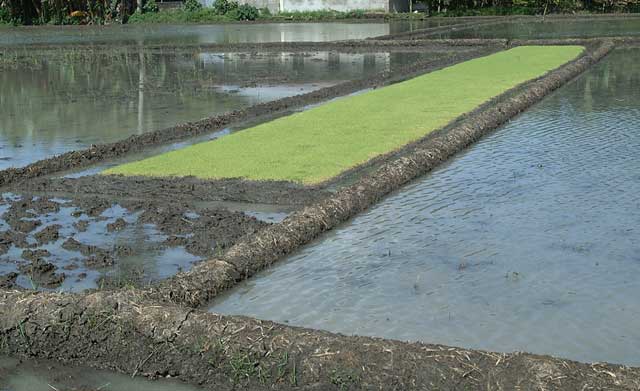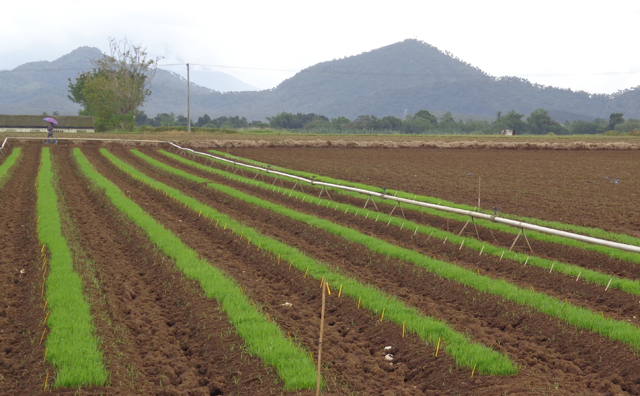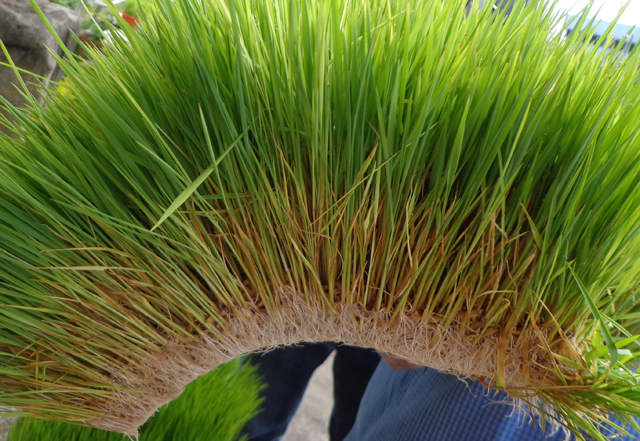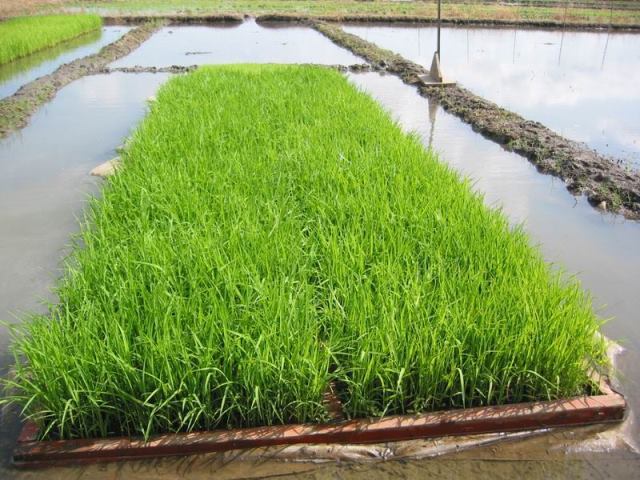How to prepare the seedlings for transplanting
Prior to transplanting, seedlings need to be raised in a nursery. Seedling nurseries usually use 5−10% of the total farming area.
When choosing the appropriate nursing system, consider the availability of sunlight, water, labor, land, and agricultural implements.
Wet-bed
 Use this method in areas with sufficient water supply. Allot 1/10 of the field for the seed bed area, and prepare 40 kg of seed to transplant 1 ha of land.
Use this method in areas with sufficient water supply. Allot 1/10 of the field for the seed bed area, and prepare 40 kg of seed to transplant 1 ha of land.
- Prepare beds at 1 m wide by convenient length. Raise the soil to 5−10 cm height.
- Broadcast pre-germinated seeds in thoroughly puddled and leveled soil.
- Construct drainage canals for proper water removal.
- Add organic manure (decompose) and a small amount of inorganic fertilizer as basal dressing. This increases seed vigor and allows easier uprooting for transplanting.
- Transplant seedlings at 15−21 days old.
Dry-bed
 Prepare the nursery in dry soil conditions. Ensure that the site is free of shade and has access to irrigation facilities. Allot 1/10 of the field for the seed bed area, and prepare 60−80 kg of seed to transplant 1 ha of land.
Prepare the nursery in dry soil conditions. Ensure that the site is free of shade and has access to irrigation facilities. Allot 1/10 of the field for the seed bed area, and prepare 60−80 kg of seed to transplant 1 ha of land.
- Prepare beds at 1 m wide by convenient length. Raise the soil to 5−10 cm in height.
- Distribute a layer of half burned paddy husk on the nursery bed to facilitate uprooting.
- Prevent moisture stress by irrigation. Without appropriate moisture, roots may be damaged during pulling.
- If nutrient supply is low, apply basal fertilizer mixture and incorporate it between rows.
- Transplant seedlings at 15−21 days old.
Seedlings raised in dry-bed are short, strong, and has a longer root system than those raised in wet-beds.
Dapog
 Dapog or mat method is most appropriate for growing short duration varieties, as seedlings experience less transplanting shock.
Dapog or mat method is most appropriate for growing short duration varieties, as seedlings experience less transplanting shock.
Compared to other methods, this requires less labor, and has minimal root damage.
Prepare dapog nurseries where a flat firm surface is available and water supply is very reliable. Allot 100 m2/ha or 1% of the field for the seedbed, and prepare 40−50 kg of seed per ha.
- Mark out 1 m wide and 10−20 m long plots.
- Cover the surface with banana leaves, plastic sheets, or any flexible material from penetrating the bottom layer of the soil. Cemented floors may also be used as base. Form the boundary with bamboo splits or banana sheath.
- Cover the seedbed with about 1 cm of burned paddy husk or compost.
- Sow pre-germinated seeds on the seedbed. Maintain a thickness of 5−6 seeds (1 kg per 1.5 m2).
- Sprinkle water to the seeds after sowing, and then press down by hand or with a wooden flat board.
- Prevent water stress by irrigation.
- Transplant seedlings at 9−14 days old.
Modified mat nursery
 The modified mat nursery uses less land and requires fewer seeds and inputs (i.e., fertilizer and water). Allot 100 m2/ha for the seedbed, and prepare 18−25 kg of good quality seeds.
The modified mat nursery uses less land and requires fewer seeds and inputs (i.e., fertilizer and water). Allot 100 m2/ha for the seedbed, and prepare 18−25 kg of good quality seeds.
- Cover the surface of 4 cm layer soil mix with banana leaves, plastic sheets, or any flexible material from penetrating the bottom layer of the soil.
- Sow pre-germinated seeds on the seedbed, then sprinkle with water. Maintain a thickness of 2−3 seeds.
- Water the nursery 2 times a day for 5 days.
- Transplant seedlings at 15−21 days old, when seedlings reach the four-leaf stage.
The bubble tray nursery follows the modified mat system to develop seedlings with root balls. Seedlings raised on bubble trays experience less transplanting shock. At 12−15 days old, seedlings are broadcast in the field.
To do this:
- Prepare 750 trays per hectare of paddy.
- Raise seedlings on plastic trays of 59 cm x 34 cm with 434 embedded holes.
Fact sheet: How to prepare the modified mat nursery
Read: How to control weeds in the nursery
How to prepare seedlings for mechanical transplanting

Grow seedlings on a thin layer of soil in 30 cm x 60 cm trays per seedling box. In some instances, seedlings are grown on larger areas and then cut into rectangular strips (mats of seedlings) that fit into the planting trays of the transplanter.